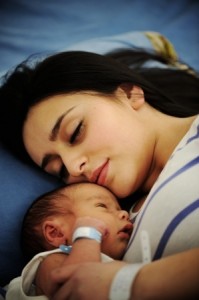
Photo Credit: 123RF Stock Photo[/caption] Home births are on the rise in the United States. Although most women still give birth in a hospital, an increasing number of women are opting, instead, to give birth at home. According to the Centers for Disease Control and Prevention (CDC), between 2011 and 2012, the number of planned home births increased by 7 percent. The reasons a woman may choose a home birth range from an attempt to avoid unnecessary medical intervention to the desire for more care and attention. Women need to be aware, however, of the risks associated with home births. According to a study conducted by New York-Presbyterian/Weill Cornell Medical Center and published in the American Journal of Obstetrics and Gynecology, researchers found that babies were four times more likely to die when delivered at home by a midwife, compared to those who delivered in the hospital with midwives. The risk was even higher for first-time moms and women who were more than 41 weeks pregnant. Proponents of home birth, on the other hand, say the study is flawed because it used data from the linked birth and infant death data set of the CDC’s VitalStats, which relies on birth certificate records that can be inaccurate and incomplete due to secondhand information and human error. Proponents of home birth point to a study in the Journal of Midwifery and Women’s Health which found that, in low-risk women who had a home birth, the risk of a baby dying was less than 1 percent as support for the safety of home births. In the event that a birth injury does happen, it is important to understand the scope of medical negligence and liability standards for midwives and home births. Medical malpractice laws provide legal recovery to patients who are injured as a result of medical negligence, or a deviation from medical standards of care. Most liability insurance companies, however, do not cover home births. Consequently, most midwives who preside over home births are certified professional midwives (CPMs). CPMs are accredited by a national midwifery organization, the North American Registry of Midwives, and to become licensed the applicant must obtained a high school diploma, completed a midwifery school or an apprenticeship under another midwife, and passed a 350-question multiple-choice exam. Twenty-seven states license CPMs to practice. Because CPMs rarely carry liability insurance, recovering money damages can be difficult – if not impossible. Even if a court were to find a CPM liable for medical malpractice, the financial recovery would be limited to the personal assets of the midwife. If you and your family are considering a home birth, it is important to consider all of the pros and cons of that birthing option, including the risks associated with a potential medical complication or the possibility for legal recovery if the worst case scenario happens. The Chicago medical malpractice lawyers at Steinberg Goodman & Kalish are committed to protecting patient rights and helping injured parties obtain maximum financial recovery if they are the victim of medical negligence. Contact our office at (312) 445-9084 to schedule a free consultation with one of our Chicago medical malpractice lawyers. Source: Home birth on the rise, but is it safe?

